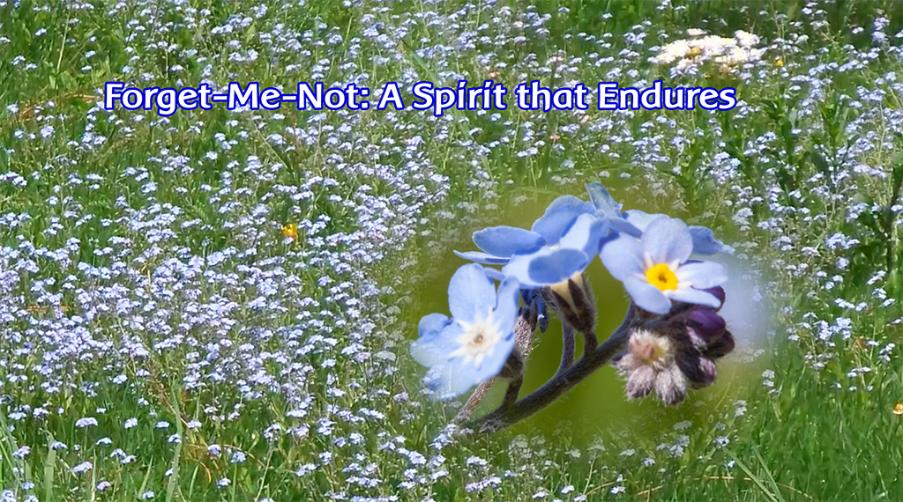
Forget-Me-Not: A Spirit that Endures
by Richard Katz
Every spring, the meadows of Terra Flora are filled with the gentle blue Forget-Me-Nots, a botanical sister of the Hound’s Tongue featured in our last post, as both are members of the Boraginaceae (Borage) plant family. Hound’s Tongue helps uplift an overly materialistic intellect into a more expanded awareness. The Borage flower provides emotional buoyancy for those weighed down by grief or despair. The Forget-Me-Not is a further development of this theme, as it provides a spiritual perspective to the soul when suffering a loss through death, with the realization that there is a spiritual connection which endures.
There are 50 different species of Forget-Me-Not. Our flower essence is made from Myosotis sylvatica, the woodland Forget-Me-Not, a European native which has naturalized throughout North America. A flower of the spring, it prefers moist habitats, with shade to partial sun. The flowers are tiny, about ¼ inch (6 mm) across, flat, with blue petals and yellow (occasionally white) raised lobes in the center. As with many of the Borage family flowers, blue flowers start in the bud stage with a pinkish hue, and then again fade to pink as they are finished, much as litmus paper changes color from pink (acidic) to blue (alkaline). The most prominent characteristic of the inflorescence is the coiled gesture of the flowering stem, sometimes called a scorpoid cyme.
The central flowers bloom first, and then the ones on the side branches, as the coil unfurls, much like the frond of a fern. As with other Boraginaceae plants, the upper part of the plant is covered with fine siliceous hairs. Although it does not have the thick mucilaginous roots of its Borage family relatives such as Hound’s Tongue, Comfrey, Lungwort, and Borage, its roots live in the moist earth. It also lacks the thick basal leaves of these botanical relatives, giving more emphasis to its relationship with the light.
The quality of remembrance is woven throughout the history of this plant. The common English name of Forget-Me-Not, from the French ne m’oubliez pas, has its origin in many folkloric understandings of this flower. In one legend, the Jesus child was sitting on Mary’s lap one day and said that he wished that future generations could see her eyes. He touched her eyes and then waved his hand over the ground and blue Forget-Me-Nots appeared. Hence one of the names of the flower is “blue eyes of Mary.” A medieval German legend describes a knight and his lady were walking along the side of a river. He picked a posy of flowers, but because of the weight of his armor, he fell into the river. As he was drowning, he threw the posy to his loved one and shouted, “Forget-me-not!” (‘Vergiss mein nicht!”)
The Forget-Me-Not has been adopted as a symbol of remembrance for many years. Six centuries ago, Henry IV of England adopted the flower as his symbol during his exile. In medieval Germany, it was worn as a symbol of faithfulness among lovers. In the twentieth century, Newfoundland adapted the Forget-Me-Not in remembrance of their war dead, and the Freemasons used Forget-Me-Not to remember those victimized by the Nazis.
Wilhelm Pelikan, in his book Healing Plants (Heilpflanzenkunde), writes about a related species, the Field Forget-Me-Not Myosotis arvensis, “How we loved them as children, linking this feeling with the heavenly home we had left behind, which all too soon fades from memory as we grow up.”
The Forget-Me-Not shares many characteristics of other essence flowers in the Borage family, mediating the balance between gravity and levity, between the watery, mucilaginous weight, the damp soil in which it is rooted, to the uplifted crystalline light of the silica-graced upper plant and inflorescence. Compared to other Borage Family plants, and even to other Forget-Me-Not species, the Wood Forget-Me-Not is more gentle, less weighed down by the water element, more readily able to uplift into the light. Its arching inflorescence of tiny sky blue flowers reach for the heavens reminding us, as Pelikan observed, of our heavenly home from whence we came (“trailing clouds of glory” in Wordsworth’s poem). In lore the Forget-Me-Not is associated with remembrance in relationships, particularly of a love that transcends death.
The flower essence soul qualities are analogous, uplifting the soul to a higher, spiritual perspective when suffering a loss, but not letting us get lost in watery emotion. It completes the soul’s struggle with materialism and emotional pain addressed by some of the other Borage family flower essences, with a transcendent awareness of a spiritual dimension, one that can awaken love forces to soothe and nourish the soul. In the words of Mitch Albom (in his book Tuesdays with Morrie), “Death ends a life, not a relationship.”
Read these articles about Forget-Me-Not flower essence:
Forget-Me-Not: Developing Soul Relationships through Dreams and Memory
Forget-Me-Not and Chico Xavier: Character Study
Forget-Me-Not portrait by a Dutch practitioner
One year after the passing of my mother, I create a video about Forget-Me-Not in her memory.

To install this Web App in your iPhone/iPad press ![]() and then Add to Home Screen.
and then Add to Home Screen.
